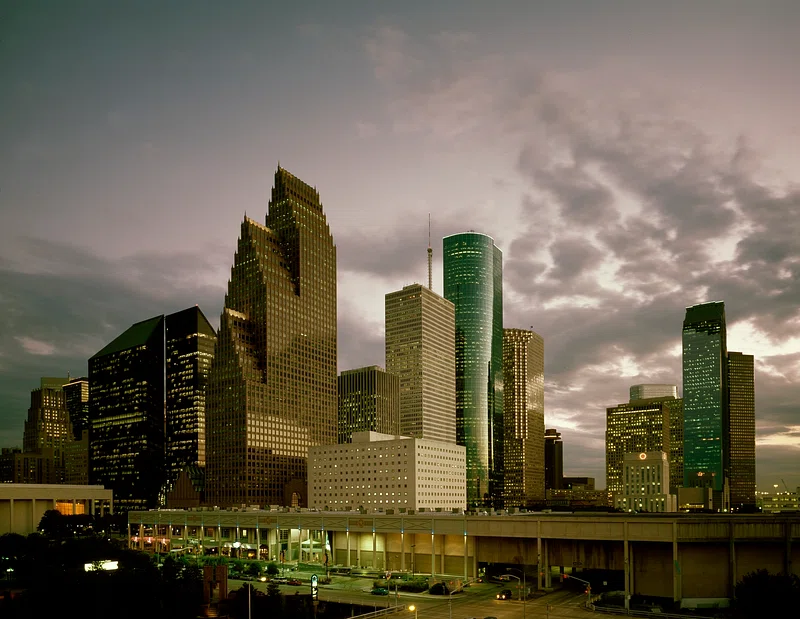Houston, Texas, often dubbed the “Space City” for its pivotal role in space exploration, has also become synonymous with rapid growth and economic dynamism. Over the past few decades, Houston has transformed into a vibrant metropolis that attracts people from across the United States and around the globe. But how did this city, once characterized by its oil-centric economy, become America’s fastest-growing city? The answer lies in a combination of economic diversification, strategic urban planning, cultural inclusivity, and geographical advantages.
Economic Diversification: Moving Beyond Oil
The Oil Boom and Beyond
Houston’s economic growth was initially fueled by the oil and gas industry. Starting in the early 20th century, the city became a hub for energy companies, earning its reputation as the energy capital of the world. The discovery of oil in Texas and the subsequent rise of the petroleum industry brought wealth and development to the region. Major corporations such as ExxonMobil, Chevron, and Shell established significant operations in Houston, creating jobs and attracting a skilled workforce.
However, the city’s leaders recognized the risks of over-reliance on a single industry. Economic downturns in the 1980s due to fluctuating oil prices underscored the need for diversification. In response, Houston broadened its economic base, investing in healthcare, technology, manufacturing, and international trade.
The Texas Medical Center
A cornerstone of Houston’s diversification is the Texas Medical Center (TMC), the largest medical complex in the world. Spanning over 2.1 square miles, the TMC is home to leading hospitals, research institutions, and medical schools. It employs over 100,000 people and attracts millions of patients annually. The medical center has made Houston a global destination for healthcare, contributing billions to the local economy.
FREE: Quickly identify and understand problems with your vehicle 🚘
CLICK HEREExpanding into Technology and Innovation
Houston has also made strides in technology and innovation. The city’s burgeoning tech scene includes startups and established companies working in fields like aerospace, biotechnology, and artificial intelligence. Initiatives such as The Ion, an innovation hub located in Midtown, foster collaboration between entrepreneurs, researchers, and investors, solidifying Houston’s position as a tech-friendly city.
A Thriving Job Market
Houston’s diversified economy has resulted in a robust job market that appeals to professionals across various industries. The city consistently ranks among the top metropolitan areas in the United States for job creation. Its unemployment rate has remained below the national average, even during economic downturns.
Key sectors contributing to Houston’s job growth include:
- Energy Transition: While traditional oil and gas remain vital, Houston is also investing in renewable energy and sustainability projects.
- Global Trade: As home to the Port of Houston, one of the busiest ports in the United States, the city plays a critical role in international trade.
- Construction and Real Estate: The demand for housing and commercial spaces has spurred growth in construction and real estate development.
Affordable Living and Real Estate Opportunities
One of Houston’s most attractive features is its affordability. Unlike many major metropolitan areas, Houston offers a relatively low cost of living, making it accessible to families, young professionals, and retirees alike. Housing costs are significantly lower than in cities like New York, Los Angeles, or San Francisco.
Suburban Expansion
The availability of land has facilitated suburban expansion, with neighborhoods like Katy, Sugar Land, and The Woodlands becoming popular choices for residents seeking spacious homes and excellent schools. These suburbs offer a balance between urban amenities and suburban tranquility, attracting both locals and newcomers.
Urban Development
Within the city limits, Houston’s urban core has seen significant redevelopment. Areas like Midtown, EaDo (East Downtown), and the Heights have undergone revitalization, featuring mixed-use developments, trendy restaurants, and cultural attractions. The city’s efforts to improve public transportation and pedestrian-friendly infrastructure have further enhanced urban living.
Cultural Inclusivity and Diversity
Houston’s rapid growth is also a testament to its cultural inclusivity and diversity. The city is one of the most ethnically diverse in the United States, with residents hailing from more than 140 countries and speaking over 90 languages. This multiculturalism is reflected in Houston’s vibrant arts, food, and entertainment scenes.
Immigration and Population Growth
Immigration has played a significant role in Houston’s population growth. The city’s welcoming attitude toward immigrants and refugees has made it a destination for those seeking new opportunities. From Vietnamese communities in the southwest to Indian enclaves in Sugar Land, Houston’s neighborhoods celebrate a rich tapestry of cultures.
Culinary Scene
Houston’s culinary landscape is a direct reflection of its diversity. The city is renowned for its food, ranging from Tex-Mex and barbecue to Vietnamese pho and Nigerian jollof rice. Food festivals and farmers’ markets further showcase the city’s culinary richness.
Geographical and Strategic Advantages
Proximity to Global Markets
Houston’s strategic location near the Gulf of Mexico positions it as a gateway to global markets. The Port of Houston facilitates trade with countries worldwide, particularly in Latin America and Asia. This accessibility has attracted businesses seeking to expand their international reach.
Climate and Natural Resources
Houston’s warm climate and access to natural resources have also contributed to its growth. The region’s fertile land supports agriculture, while its waterways enable efficient transportation and trade.
Challenges and Opportunities
While Houston’s growth story is impressive, it comes with challenges. Urban sprawl, traffic congestion, and vulnerability to hurricanes are persistent issues. The city’s leaders are actively addressing these challenges through initiatives like flood mitigation projects, improved public transportation, and sustainable urban planning.
Flood Mitigation
In the wake of devastating hurricanes like Harvey in 2017, Houston has prioritized flood control measures. Investments in reservoirs, drainage systems, and green infrastructure aim to reduce the impact of future storms.
Sustainable Growth
Houston is also focusing on sustainability. Projects like the Bayou Greenways initiative, which connects the city’s parks and trails, promote environmental conservation and enhance quality of life for residents.
The Road Ahead
Houston’s evolution from an oil town to a diverse and dynamic metropolis offers valuable lessons in resilience and adaptability. As the city continues to grow, its ability to balance economic expansion with environmental and social sustainability will be critical.
The city’s trajectory suggests a bright future. With its thriving job market, affordable living, cultural inclusivity, and strategic investments, Houston is well-positioned to remain a magnet for talent and innovation. As America’s fastest-growing city, Houston exemplifies the possibilities of visionary leadership and community-driven progress.
In conclusion, Houston’s journey to becoming a growth powerhouse is a story of transformation, opportunity, and resilience. Its success underscores the importance of adaptability and inclusivity in navigating the challenges of urban growth. For those seeking a city that embraces change and fosters innovation, Houston stands as a beacon of what is possible.


Leave a Reply